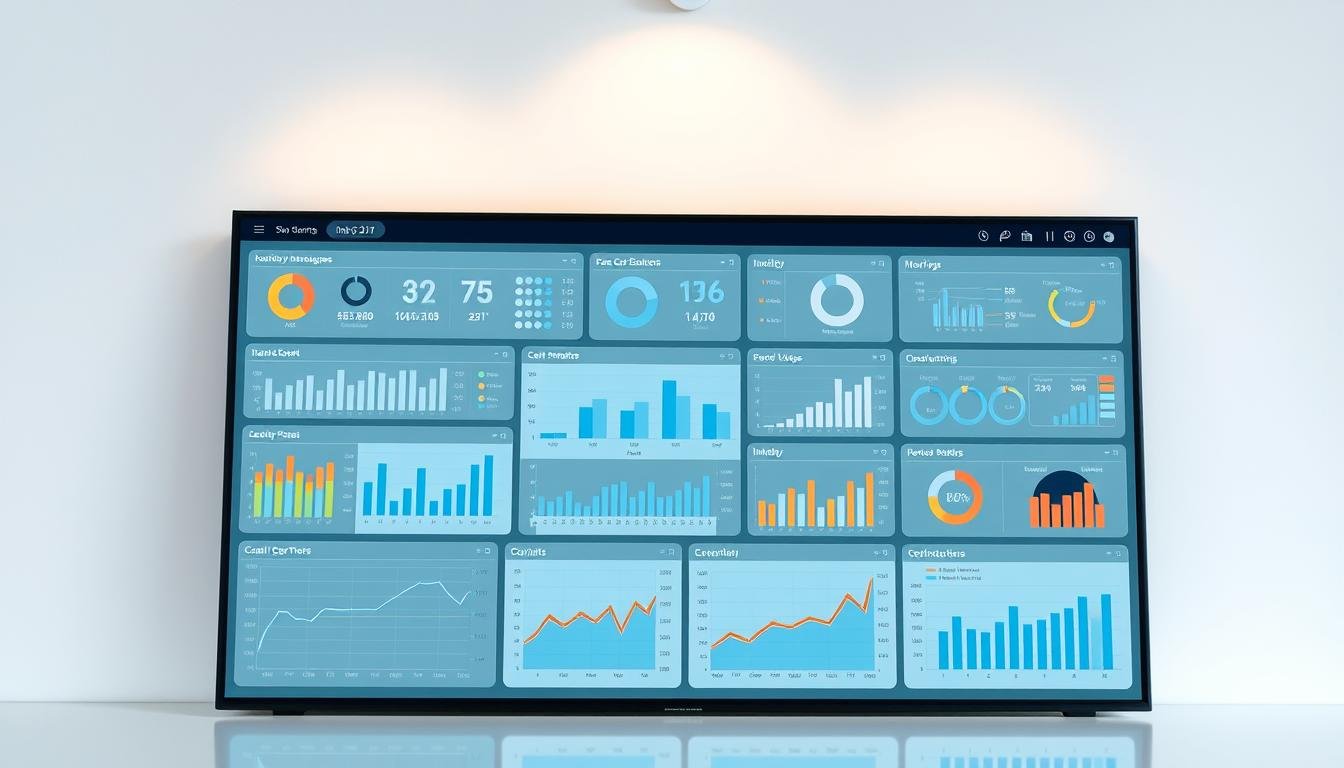I’ve seen many businesses struggle to get the most from their online data. They have lots of information but not enough clear answers. But now, thanks to top web analytics AI tools, things are changing.
These tools turn complex data into easy-to-use plans. They are like magic windows that show us what customers really want.
For those of us who know the digital world well, AI analytics platforms are key. They give us more than just numbers. They help us make smart choices for the future. And with 72% of leaders seeing better work thanks to AI, the benefits are clear.
In this guide, I’ll show you the latest web analytics AI tools. They change how companies use their online space. From quick data updates to understanding what users do, these tools are making a big difference.
Table of Contents
Key Takeaways
- AI web analytics tools provide deeper insights than traditional analytics
- Machine learning enables predictive and proactive business strategies
- Top AI tools can significantly improve digital performance
- Data-driven decisions become more accurate with AI integration
- Businesses can optimize user experience through advanced analytics
Understanding AI-Powered Web Analytics Revolution
The digital world has changed a lot with new ai website traffic analysis tools. Old ways of tracking web data are being replaced by smarter systems. These systems use artificial intelligence to find deeper insights.
AI has changed how businesses see their online success. It’s not just about how many pages are viewed or clicked. Now, companies can guess what users will do next. They can make their websites better and make choices based on data.
Evolution of Traditional Analytics
Web analytics has changed a lot. Before, businesses had to look at data by hand and use simple math. Now, AI tools can:
- Look at huge amounts of data fast
- Find complex patterns in user behavior
- Give predictions automatically
- Change reports in real-time
Benefits of AI Integration
Adding AI to web analytics brings big benefits for digital experts:
| AI Analytics Benefit | Impact |
|---|---|
| Real-time Data Processing | Instant insights and decision-making |
| Predictive User Behavior | Enhanced personalization strategies |
| Automated Reporting | Reduced manual analysis time |
“AI transforms web analytics from retrospective reporting to proactive strategic intelligence.” – Digital Transformation Experts
Core Features of Modern AI Analytics Tools
Today’s AI analytics tools have advanced features. They use machine learning to give detailed, useful insights. These insights help businesses stay ahead in the fast-changing digital world.
The Impact of Machine Learning on Website Data Analysis
Deep learning in website analytics has changed how businesses see online user actions. Machine learning gives deep insights into web performance. It turns simple data into useful information.
Neural network web metrics help companies understand user behavior well. These new tools can:
- Predict user engagement trends
- Identify where users might leave
- Offer ideas for content that fits each user
- Make website design better based on user actions
Automated web user behavior analysis is more than old analytics. It uses smart algorithms that learn and change as they go. I’ve seen how these smart systems can:
| Machine Learning Capability | Business Impact |
|---|---|
| Pattern Recognition | Finds hidden user trends |
| Predictive Modeling | Forecasts how likely users are to buy |
| Anomaly Detection | Finds unusual traffic or user actions |
The future of web analytics is in these smart systems. They can handle big data and give insights quickly.
Machine learning turns website data into moving, predictive knowledge.
Key Components of AI Analytics Platforms
AI web analytics solutions have changed how businesses use digital data. Top web analytics tools now use advanced tech to turn data into useful insights.
Today’s AI analytics platforms are complex systems. They give deep data insights. These systems have many parts that work together well.
Real-time Data Processing Capabilities
Real-time data processing is key in web analytics. Instant data streaming lets businesses:
- Watch website traffic live
- See user actions right away
- Find new patterns fast
“Speed of insight is the new competitive advantage in digital analytics” – Data Science Expert
Predictive Analytics Features
Predictive analytics use past data to guess the future. Top web analytics tools use machine learning to:
- Guess what customers will do
- Forecast how many will buy
- Spot new trends
Automated Reporting Systems
Automated reporting makes data analysis easy. It creates detailed reports with little help from humans. These systems make reports that show important data clearly.
Top Web Analytics AI Tools in Current Market

Finding the right analytics tools for web apps can be tough. I looked into the best tools that change how we see digital performance. These AI tools give deep insights into how people use websites.
The top 5 analytics tools in the market now offer special features for all kinds of businesses. Each tool has unique abilities to help companies make smart choices based on data:
- Google Analytics 4: The top choice with advanced AI
- ContentShake AI: Great for improving content
- Gumloop: Focuses on automating analytics
- Surfer SEO: Helps with content and search optimization
- FullStory: Knows all about digital experiences
These tools do more than just collect data. They use smart AI to turn website data into useful information. Now, businesses can guess what users want, improve marketing, and make websites better than ever.
Choosing the best analytics tool depends on what your business needs. Small companies might want tools that are easy on the wallet. Big companies need full-featured tools with advanced AI.
The future of web analytics is all about smart, AI-driven insights that go beyond just reports.
Google Analytics 4 with AI Capabilities
Google Analytics 4 (GA4) is a big deal in the world of web data. It uses artificial intelligence to make sense of digital data. This tool helps us understand how people interact with websites in new ways.
Unveiling Machine Learning Intelligence
GA4 uses smart machine learning to change how we see web data. It finds patterns and oddities in big data sets. This helps businesses find trends that others might miss.
Predictive Metrics and Strategic Insights
The platform’s predictive tools give businesses a big edge:
- Churn probability prediction
- Purchase likelihood estimation
- Customer lifetime value forecasting
These tools help predict what users might do next. This lets businesses make smart choices based on data.
Advanced User Behavior Analysis
GA4’s AI is great at mapping out user journeys. It tracks how users move between devices. This gives a full picture of how customers interact with websites.
GA4 turns raw data into useful information. It helps connect data collection to making smart decisions.
ContentShake AI for SEO Optimization
ContentShake AI is a top tool for digital marketers. It uses smart content optimization. This tool changes how businesses make content and plan for SEO.
It stands out by mixing new language models with Semrush’s SEO data. This lets businesses make content that really speaks to their audience.
- Generate trending topic suggestions in specific niches
- Create detailed SEO content outlines
- Provide actionable optimization scores
- Customize brand voice across content
The real magic of ContentShake AI lies in its ability to understand and predict content performance before publication. It looks at keyword trends and audience engagement. This helps marketers make content that ranks well and connects with readers.
“ContentShake AI transforms raw data into strategic content insights, giving marketers a competitive edge in the digital landscape.”
Digital marketing teams can now make content faster. They spend less time on research and optimization. Yet, they keep making high-quality, targeted content.
Gumloop: The Next Generation of Analytics Automation
Gumloop is changing how we track website data with its new tech. It makes it easy for businesses to get insights from their website data. This is thanks to its simple design.
Gumloop is a big step forward in making data analysis easier. It uses smart AI to help businesses understand their data better.
Seamless Integration Capabilities
The platform makes it easy to connect different AI tools to your current systems. You don’t need to know how to code. The main benefits are:
- Instant connection with multiple data sources
- Minimal technical configuration requirements
- Compatibility with various enterprise systems
Custom Workflow Creation
Businesses can make their own analytics workflows. Gumloop’s flexible architecture lets users create complex data pipelines easily.
| Workflow Feature | Functionality |
|---|---|
| Automated Data Mapping | Intelligently connects data streams |
| Custom Rule Generation | Defines specific analysis parameters |
| Real-time Adaptation | Adjusts workflows dynamically |
Real-time Performance Monitoring
Gumloop gives instant insights into how well your site is doing. It lets businesses track important metrics and make quick decisions. The platform’s tools are fast and accurate.
“Gumloop transforms complex data analysis into an intuitive, streamlined experience” – Tech Innovation Review
Surfer SEO’s AI-Driven Content Analysis

I found a tool that changes how we make content better. Surfer SEO uses deep learning to help websites get better. It uses smart web metrics to do this.
This tool uses artificial intelligence to give deep insights. It looks at many important things. Surfer SEO helps make content that search engines and people like.
- Automated web user behavior analysis
- Real-time content scoring mechanisms
- Comprehensive SEO optimization recommendations
What makes Surfer SEO special is how it makes complex data easy to use. It looks at things like:
- Keyword density
- Content readability
- Structural optimization
- Competitive content benchmarking
Digital marketers can now use AI to make content better. Surfer SEO uses smart algorithms to turn data into good content advice. This helps websites rank higher.
Surfer SEO transforms content strategy from guesswork to data-driven precision.
Using this tool, businesses can see big improvements online. Surfer SEO keeps up with search engine changes. This makes sure your content stays ahead.
FullStory’s Digital Experience Intelligence
FullStory is a top web analytics tool. It changes how businesses see digital interactions. This platform captures every detail of user experiences.
FullStory uses AI to understand web analytics in a new way. The tool tracks user interactions closely. It looks at:
- Cursor movements
- Page visits
- Click patterns
- User navigation flows
FullStory is special among web analytics tools. It makes “digital stories” for each user session. It uses machine learning to:
- Find user behavior patterns
- Spot website problems
- Give tips for improvement
| Feature | Capability | Business Impact |
|---|---|---|
| Session Replay | Full user journey visualization | Enhanced UX understanding |
| AI Analysis | Automatic insights generation | Faster decision-making |
| Conversion Tracking | Detailed user interaction mapping | Improved conversion rates |
FullStory gives deep insights into digital experiences. This helps businesses make smart choices. It improves user happiness and profits.
Albert.ai for Digital Advertising Analytics
Digital advertising is changing fast. Businesses need to stay ahead. Albert.ai is a new AI platform that changes how we do digital ads.
Albert.ai is a top tool for digital marketers. It uses AI to give deep insights and improve ads across many channels.
Campaign Optimization Features
Albert.ai makes managing ads better. It has special features like:
- Automated budget allocation across channels
- Real-time performance adjustments
- Dynamic creative optimization
- Cross-platform campaign management
Audience Targeting Capabilities
Albert.ai uses smart learning to find the right people for ads. It looks at big data to find the best audience. This means ads reach the right people.
ROI Tracking and Analysis
Albert.ai makes it easy to see how ads do. It shows detailed results. This helps marketers see where ads work best.
“Albert.ai represents the future of data-driven digital advertising analytics” – Digital Marketing Insights
Implementation Strategies for AI Analytics Tools
Using the best data analysis tools needs a smart plan. This plan makes your business smarter. As an expert, I’ve made a detailed plan for AI analytics to work well.
The first step is to check your data setup. Companies must look at their current systems. They need to find where AI tools can fit in.
- Conduct a thorough organizational readiness assessment
- Define clear implementation objectives
- Develop a phased rollout strategy
- Create extensive training programs
Key implementation considerations include:
- Matching with current tech setup
- Getting data ready and checking its quality
- Training teams and managing change
- Keeping an eye on how things are going
“Successful AI analytics implementation is not about technology, but about transforming organizational capabilities.” – Data Strategy Experts
I suggest starting small. Begin with test projects in certain areas. Learn from them, then grow to more parts of the company. This way, you learn and adapt without big problems.
By using these steps, businesses can really use AI analytics. This leads to better choices and staying ahead of the competition.
Data Privacy and Security Considerations
Using top web analytics AI tools is getting more complex. Businesses must protect user info well. This keeps trust high.
Data protection is key in the digital world. AI analytics platforms must follow strict rules. This changes how they handle data.
Essential GDPR Compliance Strategies
To follow GDPR, you need a few steps:
- Make data collection clear
- Get user consent for data use
- Offer easy ways to opt out
- Use data only when needed
Data Protection Protocols
Web analytics tools need strong security. Important steps include:
- Encrypt data from start to end
- Do security checks often
- Limit who can see data
- Hide personal info
User Privacy Standards
AI analytics must balance privacy and insights. Proactive privacy protection is key.
Privacy is not an optional feature—it’s a fundamental requirement in today’s digital landscape.
Following strict privacy rules helps. This way, businesses can use AI analytics safely. They keep user trust and follow laws.
Cost-Benefit Analysis of AI Analytics Investment
Investing in tools for ai website traffic analysis needs a smart plan. It’s not just about the cost. You must look at the benefits and how they will help you in the long run.
When you do a cost-benefit analysis, focus on a few important things:
- Initial costs to start
- Costs to keep it running
- How it can make you more productive
- Ways it can help you make more money
AI can change how you use data, but you need to measure its effect. Here are the main money points to think about:
| Cost Category | Estimated Investment | Potential Return |
|---|---|---|
| Software Licensing | $5,000 – $20,000/year | Smarter decisions |
| Infrastructure Upgrades | $10,000 – $50,000 | Better work flow |
| Training Expenses | $2,000 – $15,000 | More productive team |
Studies show you can see the benefits in 1-2 years. The trick is to pick the right tools for your goals and be open to change.
Strategic investment in AI analytics turns data into a strong advantage.
Looking at both the obvious and hidden benefits helps choose and use ai tools wisely.
Future Trends in AI Web Analytics
The world of deep learning website analytics is changing fast. It brings new insights into how we use the internet. AI is changing how we see web metrics, making it better for businesses.
New trends in neural network web metrics are exciting:
- Advanced predictive analytics powered by machine learning
- Seamless integration with Internet of Things (IoT) devices
- Enhanced natural language processing capabilities
- Real-time sentiment and intent detection
I think we will see big changes in AI web analytics soon. Intelligent systems will guess what users will do with great accuracy. This will help businesses make digital experiences that fit each user better.
Important areas for future growth include:
- Improved data privacy mechanisms
- More sophisticated algorithmic models
- Cross-platform user journey mapping
- Ethical AI implementation strategies
As tech gets better, businesses need to keep up. They should use these new deep learning website analytics tools. This will help them stay ahead in the digital world.
Common Challenges and Solutions in AI Analytics Implementation
Using ai-driven web analytics can be tough for businesses. They want to use the best web analytics tools. But, there are big challenges that can stop them from using AI analytics well.
Finding the right web analytics tools is hard. You need a good plan to get past these problems.
Technical Integration Challenges
Getting tech to work together is a big problem. The main issues are:
- Matching with current tech setup
- Moving data around is hard
- Connecting systems smoothly
- APIs can be a limit
Team Adoption Strategies
Getting your team to use AI analytics is key. Here’s how to do it:
- Offer good training
- Show how it helps
- Make data a part of your culture
- Keep learning going
Performance Optimization Tips
To get the most from AI analytics, keep improving:
| Optimization Area | Key Strategies |
|---|---|
| Data Quality | Keep data clean and checked |
| Model Accuracy | Keep training algorithms |
| Insight Generation | Use custom reports |
“The success of AI analytics lies not in the technology itself, but in how effectively it’s integrated and utilized.” – AI Analytics Expert
By tackling these challenges smartly, companies can make the most of AI web analytics. They can turn their data into valuable insights.
Conclusion
The world of web application analytics has changed a lot. New tools using artificial intelligence are now key for businesses. They help find deeper digital insights and get ahead of the competition.
Looking at the top 5 analytics tools, we see a big change. Machine learning and AI are changing how we understand users and make digital experiences better. Tools like Google Analytics 4 and Surfer SEO show how smart data analysis works today.
But these new tools also bring big challenges. Companies must deal with technical issues, keep data safe, and use AI wisely. The future is for those who can turn data into useful information.
As digital worlds keep changing, staying up-to-date is key. Using these new analytics tools can give businesses deep insights. It can also make user experiences better and keep them ahead in a world driven by data.
FAQ
What are AI-powered web analytics tools?
AI-powered web analytics tools are advanced software. They use artificial intelligence and machine learning. They collect, analyze, and interpret website data. These tools give deeper insights and predict user behavior. They help businesses make better digital strategy decisions.
How do AI analytics differ from traditional web analytics?
AI analytics offer real-time insights and predictive modeling. They find complex user behavior patterns and predict trends. They give personalized recommendations that traditional tools can’t.
Are AI web analytics tools suitable for small businesses?
Yes, AI web analytics tools are available for all business sizes. Small businesses can use tools like Google Analytics 4 and Surfer SEO. These tools offer advanced analytics without a big investment.
What key features should I look for in an AI web analytics tool?
Look for real-time data processing and predictive analytics. Also, automated reporting and user behavior analysis are important. Machine learning capabilities, integration options, and data privacy are key too.Tools like FullStory and Albert.ai provide detailed insights in these areas.
How do AI analytics tools protect user privacy?
Good AI analytics tools protect user data strongly. They follow GDPR, encrypt data, and store it securely. They also have clear data collection policies. They anonymize user data and ask for consent. This way, businesses can get insights while respecting privacy.
What is the cost range for AI web analytics tools?
Prices vary a lot. You can find free tools like Google Analytics 4 or spend hundreds or thousands of dollars monthly. The cost depends on features, data processing, team size, and customization. Most tools have different pricing tiers for various needs and budgets.
Can AI analytics tools integrate with my existing marketing stack?
Yes, most AI analytics tools integrate well with other systems. Tools like Gumloop and Albert.ai work with marketing tech, CRM systems, and more. This ensures smooth data flow and complete insights.
How quickly can I see results from implementing AI web analytics?
Results can vary, but many see insights in weeks. The setup and training period usually takes 1-3 months. Then, you get advanced predictive and analytical capabilities.
What are the primary challenges in implementing AI analytics tools?
Challenges include technical integration, data quality, team training, and AI model configuration. Success needs a strategic approach, clear goals, and ongoing optimization.
How do AI analytics tools improve website performance?
AI analytics tools give deep insights into user behavior. They find conversion barriers, predict trends, and offer optimization recommendations. They help improve site design and create personalized experiences.












